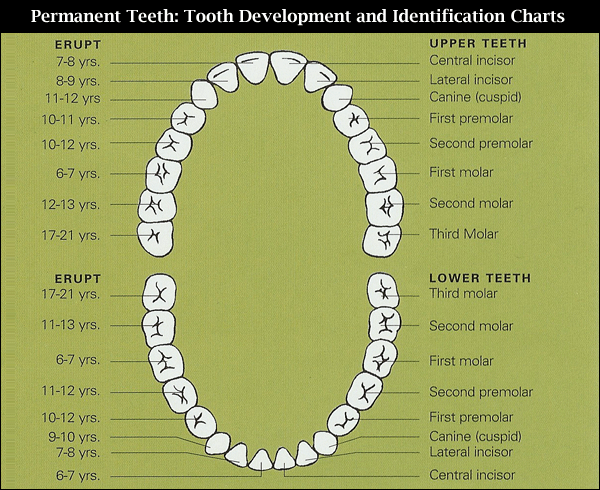What are teeth made of?
Tooth anatomy
A tooth is made up of 3 hard tissues and 1 soft tissue.
The hard tissue are :
The hard tissue are :
- Enamel - The hardest tissue in our body.
- Dentin - Hard tissue which is harder than bone but not enamel. It protects the inner part of the tooth, called the pulp.
- Cementum - Hard tissue which is similar to bone but is avascular (without blood supply). It covers the root of the tooth and periodontal fibres connect the tooth to the jawbone.
The soft tissue of the tooth is pulp where each tooth's blood supply and nerve endings are found.
- The blood supply is what keeps the teeth alive and healthy.
- The nerve endings send messages to the brain, such as whether you're eating something hot or cold or if you have a decayed or damaged tooth.
Types of teeth
There are four different types of teeth :
There are four different types of teeth :
- Incisors. These are your four front teeth on the top and bottom jaw. They are used for cutting and chopping food.
- Canine teeth. These are sharp, pointy teeth. You have one on each side of your incisors on your top and bottom jaw, making a total of four. They help to tear food.
- Premolars. Next to your canine teeth are your premolars (also called bicuspid teeth). You have eight premolars in total, four on your top jaw and four on the bottom. They are bigger and wider than your incisors and canine teeth, and are used for crushing and grinding food.
- Molars. You have eight molars, four on top and four on the bottom. These are your strongest teeth and work with your tongue to help you swallow food, mashing it up until it's ready to be swallowed safely.
General types of teeth
A simple look at tooth eruption
Tooth eruption is a process in tooth development in which the teeth enter the mouth and become visible. The first human teeth to appear is primary teeth, also known as baby teeth or milk teeth in a process called "teething".
Milk teeth
Babies' teeth begin to develop before they are born, but in most cases don't come through until they're between 6 and 12 months old. Most children have a full set of 20 milk or baby teeth by the time they're three years old. When they reach five or six, these teeth will start to fall out, making way for adult teeth.
Baby Eruption Patterns
- Teeth tend to erupt in pairs
- Lower teeth usually erupt before the upper teeth
- Girls generally preceded boys in tooth eruption
- The teeth in both jaws usually erupt in pairs - one on the right and one on the left
- By the time the child reaches the age of two to three years, all the deciduous (baby) teeth should have erupted
Adult teeth
By the age of 12 to 14, most children have lost all their baby teeth and have their adult teeth. There are 32 adult teeth in total, 12 more than in the baby set. The last four of these, called wisdom teeth, usually emerge later than the others, generally between the ages of 17 and 21.
Here's an identification chart of tooth development :

.jpg)

No comments:
Post a Comment